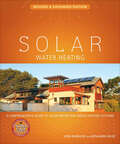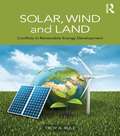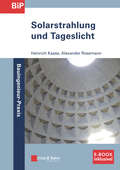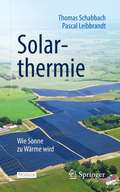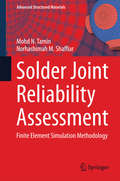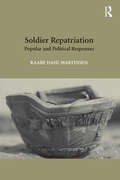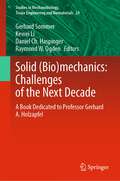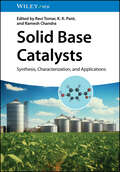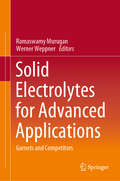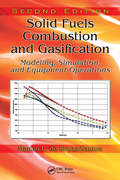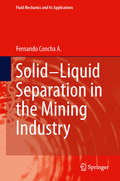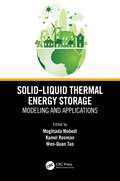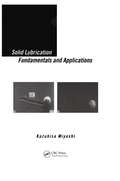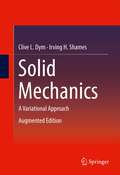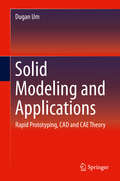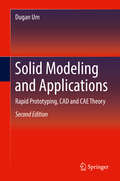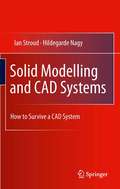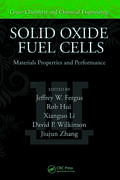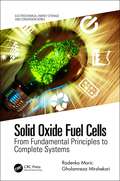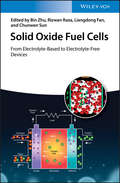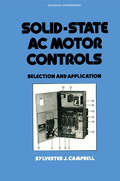- Table View
- List View
Solar Water Heating: A Comprehensive Guide to Solar Water and Space Heating Systems (Mother Earth News Books for Wiser Living)
by Bob Ramlow Benjamin NuszHeating water with the sun is a practice almost as old as humankind itself. Solar Water Heating , now completely revised and expanded, is the definitive guide to this clean and cost-effective technology. Beginning with a review of the history of solar water and space heating systems from prehistory to the present, Solar Water Heating presents an introduction to modern solar energy systems, energy conservation and energy economics. Drawing on the authors' experiences as designers and installers of these systems, the book goes on to cover:Types of solar collectors, solar water and space heating systems and solar pool heating systems, including their advantages and disadvantagesSystem components, their installation, operation, and maintenanceSystem sizing and sitingChoosing the appropriate system.This book focuses on the financial aspects of solar water or space heating systems, clearly showing that such systems generate significant savings in the long run. With many diagrams and illustrations to complement the clearly-written text, this book is designed for a wide readership ranging from the curious homeowner to the serious student or professional.
Solar, Wind and Land: Conflicts in Renewable Energy Development
by Troy A. RuleThe global demand for clean, renewable energy has rapidly expanded in recent years and will likely continue to escalate in the decades to come. Wind and solar energy systems often require large quantities of land and airspace, so their growing presence is generating a diverse array of new and challenging land use conflicts. Wind turbines can create noise, disrupt views or radar systems, and threaten bird populations. Solar energy projects can cause glare effects, impact pristine wilderness areas, and deplete water resources. Developers must successfully navigate through these and myriad other land use conflicts to complete any renewable energy project. Policymakers are increasingly confronted with disputes over these issues and are searching for rules to effectively govern them. Tailoring innovative policies to address the unique conflicts that arise in the context of renewable energy development is crucial to ensuring that the law facilitates rather than impedes the continued growth of this important industry. This book describes and analyses the property and land use policy questions that most commonly arise in renewable energy development. Although it focuses primarily on issues that have arisen within the United States, the book’s discussions of international policy differences and critiques of existing approaches make it a valuable resource for anyone exploring these issues in a professional setting anywhere in the world.
Solarstrahlung und Tageslicht (Bauingenieur-Praxis)
by Heinrich Kaase Alexander RosemannDer Solarstrahlung kommt für das Leben auf der Erde die größte Bedeutung zu. Dieses Thema wird in diesem Buch aufgegriffen. Nach einer Beschreibung des Prozesses der Strahlungserzeugung und des Durchganges der Solarstrahlung durch die Erdatmosphäre werden die Wechselwirkungen durch physikalische, chemische, biologische und medizinische Effekte beschrieben. Da über verschiedene Formen der Sonnenenergiewandlung bereits eine kompetente Fachliteratur vorliegt, wird hier auf die entsprechenden Ausführungen verzichtet. Dagegen wird auf die Wirkungen über das menschliche Auge - also auf das Tageslicht - besonders eingegangen. Tageslicht als passive Solarstrahlungstechnik dient nicht nur der Beleuchtung von Innenräumen der Gebäude, es kann auch einen merklichen Anteil der Energieeinsparung liefern. Der Jahresumsatz der Energie eines Gebäudes hängt von den verwendeten wärmetechnischen Installationen, den architektonischen Gegebenheiten und der Kunstlichttechnik ab. So werden technische Lösungen sowie Komponenten beispielhaft zusammengestellt und Berechnungsverfahren und technische Regel angegeben. Besonderer Augenmerk wird auf eine qualifizierte, integrale Gebäudeplanung gelegt, die auf den Bedürfnissen der Nutzer basiert und somit nicht nur die energetische Gesamtbilanz verbessert, sondern gleichzeitig die Aufenthaltsqualität erhöht. Dieses Buch führt in die notwendigen physikalischen und meteorologischen Zusammenhänge von Solarstrahlung und Tageslicht ein, indem die doppelt spektralen Zusammenhänge von Strahlung und Effekt, wie die lichttechnischen und strahlungsphysikalischen Kennzahlen und die gesundheitlichen Wirkungen erläutert werden. Das Buch erläutert zudem Verfahren zur Bestimmung des Energieumsatzes mit Planungstools. Das Buch ist für Architekten, Bauingenieure, Gebäudetechniker, Lichttechniker, Arbeitsmediziner, Meteorologen und Umwelttechniker in Planungspraxis, Industrie, Forschung und Lehre geeignet.
Solarthermie: Wie Sonne zu Wärme wird (Technik im Fokus)
by Thomas Schabbach Pascal LeibbrandtWelchen Beitrag kann die Solarthermie zur Energiewende leisten? Was kostet Solarwärme und und wo sind ihre Grenzen?Nach einem kurzen Überblick über die Möglichkeiten regenerativer Wärmeversorgung führen die Autoren in die physikalischen Grundlagen der Solarstrahlung und der Strahlungswandlung ein. Dann erläutern sie die Funktionsweise der Solarkollektoren und der wichtigsten anlagentechnischen Komponenten anhand zahlreicher Abbildungen.Weitere Kapitel beleuchten die Einsatzmöglichkeiten und auch die Wirtschaftlichkeit solarthermischer Anlagen - von der Trinkwassererwärmung und Heizungsunterstützung bis hin zur Kühlung und zur Stromerzeugung.Das Buch vermittelt auch dem Laien einen guten Einstieg in diese wichtige und beim Umbau des Energiesystems unverzichtbare Technologie.
Solder Joint Reliability Assessment
by Mohd N. Tamin Norhashimah M. ShaffiarThis book presents a systematic approach in performing reliability assessment of solder joints using Finite Element (FE) simulation. Essential requirements for FE modelling of an electronic package or a single reflowed solder joint subjected to reliability test conditions are elaborated. These cover assumptions considered for a simplified physical model, FE model geometry development, constitutive models for solder joints and aspects of FE model validation. Fundamentals of the mechanics of solder material are adequately reviewed in relation to FE formulations. Concept of damage is introduced along with deliberation of cohesive zone model and continuum damage model for simulation of solder/IMC interface and bulk solder joint failure, respectively. Applications of the deliberated methodology to selected problems in assessing reliability of solder joints are demonstrated. These industry-defined research-based problems include solder reflow cooling, temperature cycling and mechanical fatigue of a BGA package, JEDEC board-level drop test and mechanisms of solder joint fatigue. Emphasis is placed on accurate quantitative assessment of solder joint reliability through basic understanding of the mechanics of materials as interpreted from results of FE simulations. The FE simulation methodology is readily applicable to numerous other problems in mechanics of materials and structures.
Soldier Repatriation: Popular and Political Responses
by Kaare Dahl MartinsenSoldier repatriation from Afghanistan has impacted debate about the war. This study highlights this impact with particular focus on Britain, Denmark and Germany. All three countries deployed soldiers soon after the 9/11 attacks, yet their role in Afghanistan and the casualty rates suffered, have been vastly different. This book looks at how their casualties influenced the framing of the war by analysing the political discourse about the casualties, how the media covered the repatriation and the burials, and how the dead were officially recognised and commemorated. Explaining how bodies count is not done exclusively by focusing on the political leadership and the media in the three countries, the response from the men and women in Afghanistan to the official framing of the war is given particular weight. Martinsen contributes to our understanding of European strategic culture by showing how countries respond to the same security challenges.
Solid: A Book Dedicated to Professor Gerhard A. Holzapfel (Studies in Mechanobiology, Tissue Engineering and Biomaterials #24)
by Gerhard Sommer Kewei Li Daniel Ch. Haspinger Raymond W. OgdenThis book offers a comprehensive and timely overview of the latest developments in the field of biomechanics and extensive knowledge of tissue structure, function, and modeling. Gathering chapters written by authoritative scientists, it reports on a range of continuum and computational models of solids, and related experimental works, for biomechanical applications. It discusses cutting-edge advances such as constitutive modeling and computational simulation of biological tissues and organs under physiological and pathological conditions, and their mechanical characterization. It covers innovative studies on arteries, heart, valvular tissue, and thrombus, brain tumor, muscle, liver, kidney, and stomach, among others. Written in honor of Professor Gerhard A. Holzapfel, the book provides specialized readers with a thorough and timely overview of different types of modeling in biomechanics, and current knowledge about biological structures and function.
Solid Base Catalysts: Synthesis, Characterization, and Applications
by K. K. Pant Ravi Tomar Ramesh ChandraFoundational knowledge and practical approaches of an interesting catalyst class for greener and cleaner chemical synthesis Solid Base Catalysts provides insights and information on cutting-edge heterogeneous catalysis technologies and approaches of non-corrosive and easy-to-use solid catalysts that can replace conventional liquid catalysts that are known to pose operational problems. Edited by three highly qualified authors with contributions from experts in industry and academia, Solid Base Catalysts includes: Latest and most advanced studies in the characterization of solid catalysts, with applications in various organic transformationsVersatile reaction types where solid catalysts can be used as well as the multidisciplinary nature of solid base catalyst research and its connections to other fieldsMulticomponent reactions for eco-compatible heterocyclic synthesis over solid catalysts and synthesis routes, experimental protocols, and other considerations for optimizing catalyst propertiesAdvanced methodologies and applications for analyzing solid catalysts and challenges and future prospects in the field Solid Base Catalysts is a complete reference on the subject for researchers and professionals in materials science, green chemistry, surface chemistry, and chemical engineering.
Solid Electrolytes for Advanced Applications: Garnets and Competitors
by Ramaswamy Murugan Werner WeppnerThis book highlights the state of the art in solid electrolytes, with particular emphasis on lithium garnets, electrolyte-electrode interfaces and all-solid-state batteries based on lithium garnets. Written by an international group of renowned experts, the book addresses how garnet-type solid electrolytes are contributing to the development of safe high energy density Li batteries. Unlike the flammable organic liquid electrolyte used in existing rechargeable Li batteries, garnet-type solid electrolytes are intrinsically chemically stable in contact with metallic lithium and potential positive electrodes, while offering reasonable Li conductivity. The book's respective chapters cover a broad spectrum of topics related to solid electrolytes, including interfacial engineering to resolve the electrolyte-electrode interfaces, the latest developments in the processing of thin and ultrathin lithium garnet membranes, and fabrication strategies for the high-performance solid-state batteries.This highly informative and intriguing book will appeal to postgraduate students and researchers at academic and industrial laboratories with an interest in the advancement of high energy-density lithium metal batteries
Solid Fuels Combustion and Gasification: Modeling, Simulation, and Equipment Operations Second Edition (Mechanical Engineering)
by Marcio L. de Souza-SantosAs an increasing number of professionals and graduate students enter the field of solid-based power generation, they all require an command of process and equipment, as well as the theory behind it all. However, their informational needs and understanding differ based on their experience and the task at hand.Solid Fuels Combustion and Gasification:
Solid, Liquid, Gassy! (Fairy Science)
by Ashley SpiresFairy scientist Esther is experimenting with the water cycle in this enchanting STEM-and-magic-filled follow-up to Fairy Science, a picture book from the award-winning author-illustrator of The Most Magnificent Thing!When a pond dries up, fairy scientist Esther doesn't freeze under the pressure. She and her friends go full steam ahead for to make a scientific discovery! Bestselling author Ashley Spires (The Most Magnificent Thing) creates a charming primer to the water cycle. Includes an at-home water experiment for the budding scientist in your house!
Solid-Liquid Separation in the Mining Industry
by Fernando Concha A.This book covers virtually all of the engineering science and technological aspects of separating water from particulate solids in the mining industry. It starts with an introduction to the field of mineral processing and the importance of water in mineral concentrators. The consumption of water in the various stages of concentration is discussed, as is the necessity of recovering the majority of that water for recycling. The book presents the fundamentals under which processes of solid-liquid separation are studied, approaching mixtures of discrete finely divided solid particles in water as a basis for dealing with sedimentation in particulate systems. Suspensions, treated as continuous media, provide the basis of sedimentation, flows through porous media and filtration. The book also considers particle aggregations, and thickening is analyzed in depth. Lastly, two chapters cover the fundamentals and application of rheology and the transport of suspensions. This work is suitable for researchers and professionals in laboratories and plants, and can also serve as additional reading for graduate courses on solid liquid separation as well as for advanced undergraduate and graduate level students for courses of fluid mechanics, solid-liquid separation, thickening, filtration and transport of suspensions in tubes and channels.
Solid-Liquid Thermal Energy Storage: Modeling and Applications
by Moghtada MobediSolid–Liquid Thermal Energy Storage: Modeling and Applications provides a comprehensive overview of solid–liquid phase change thermal storage. Chapters are written by specialists from both academia and industry. Using recent studies on the improvement, modeling, and new applications of these systems, the book discusses innovative solutions for any potential drawbacks. This book: Discusses experimental studies in the field of solid–liquid phase change thermal storage Reviews recent research on phase change materials Covers various innovative applications of phase change materials (PCM) on the use of sustainable and renewable energy sources Presents recent developments on the theoretical modeling of these systems Explains advanced methods for enhancement of heat transfer in PCM This book is a reference for engineers and industry professionals involved in the use of renewable energy systems, energy storage, heating systems for buildings, sustainability design, etc. It can also benefit graduate students taking courses in heat transfer, energy engineering, advanced materials, and heating systems.
Solid-Liquid Two-Phase Flow in Centrifugal Pump (Fluid Mechanics and Its Applications #136)
by Zuchao Zhu Yi Li Zhe LinThis book conducts a systematic study on internal flow characteristics and performance of centrifugal pump for solid–liquid mixed transportation. First, the applicability of the computational model for two-phase flow is analyzed. Then the relationship between the two-phase flow characteristics and wall wear in the pipeline is revealed. And the flow characteristics in centrifugal pumps are analyzed in relation to conveying performance and wall wear. Finally, the engineering application calculation of the mixed transportation pump with different impeller structures is carried out. The target audience of this book is researchers who perform calculations and engineering applications of solid–liquid two-phase pumps.This book considers the influence of the particle size on the force magnitude of the particles and analyzes the applicability of different solid–liquid two-phase calculation models. Considering the different motion trajectories of particles colliding with dry wall, wet wall, stationary wall, and moving wall, visual experiments are used to study the collision rebound model of different walls. The collision rebound model is applied to the numerical simulation of solid–liquid mixed transport.
Solid Lubrication Fundamentals and Applications (Materials Engineering)
by Kazuhisa MiyoshiSolid Lubrication Fundamentals and Applications description of the adhesion, friction, abrasion, and wear behavior of solid film lubricants and related tribological materials, including diamond and diamond-like solid films. The book details the properties of solid surfaces, clean surfaces, and contaminated surfaces as well as discussing the structu
Solid Mechanics
by Clive L. Dym Irving H. ShamesSolid Mechanics: A Variational Approach, Augmented Edition presents a lucid and thoroughly developed approach to solid mechanics for students engaged in the study of elastic structures not seen in other texts currently on the market. This work offers a clear and carefully prepared exposition of variational techniques as they are applied to solid mechanics. Unlike other books in this field, Dym and Shames treat all the necessary theory needed for the study of solid mechanics and include extensive applications. Of particular note is the variational approach used in developing consistent structural theories and in obtaining exact and approximate solutions for many problems. Based on both semester and year-long courses taught to undergraduate seniors and graduate students, this text is geared for programs in aeronautical, civil, and mechanical engineering, and in engineering science. The authors' objective is two-fold: first, to introduce the student to the theory of structures (one- and two-dimensional) as developed from the three-dimensional theory of elasticity; and second, to introduce the student to the strength and utility of variational principles and methods, including briefly making the connection to finite element methods. A complete set of homework problems is included.
Solid Mechanics
by William HosfordHosford (emeritus, materials science, U. of Michigan), who has extensive publications in the field, has written a textbook focused on the mechanics of solids for students of mechanical engineering. Drawing much of the material from his earlier text, Mechanical behavior of materials, Hosford presents a clearly organized text that assumes students already have a knowledge of materials science and statics, allowing for an uncluttered presentation of the science, testing, and principles of stress and strain, elasticity, mechanical testing, plasticity, viscoelasticity, creep and stress rupture, ductility and fracture, and fatigue. Chapters on polymers, ceramics, and composites are included, as is a concluding chapter on anisotropy. Study problems are included throughout the text. Annotation ©2010 Book News, Inc. , Portland, OR (booknews. com)
Solid Modeling and Applications
by Dugan UmThe lessons in this fundamental text equip students with the theory of Computer Assisted Design (CAD), Computer Assisted Engineering (CAE), the essentials of Rapid Prototyping, as well as practical skills needed to apply this understanding in real world design and manufacturing settings. The book includes three main areas: CAD, CAE, and Rapid Prototyping, each enriched with numerous examples and exercises. In the CAD section, Professor Um outlines the basic concept of geometric modeling, Hermite and Bezier Spline curves theory, and 3-dimensional surface theories as well as rendering theory. The CAE section explores mesh generation theory, matrix notion for FEM, the stiffness method, and truss Equations. And in Rapid Prototyping, the author illustrates stereo lithographic theory and introduces popular modern RP technologies. Solid Modeling and Applications: Rapid Prototyping, CAD and CAE Theory is ideal for university students in various engineering disciplines as well as design engineers involved in product design, analysis, and validation.
Solid Modeling and Applications: Rapid Prototyping, Cad And Cae Theory
by Dugan UmThis updated, second edition provides readers with an expanded treatment of the FEM as well as new information on recent trends in rapid prototyping technology. The new edition features more descriptions, exercises, and questions within each chapter. In addition, more in-depth surface theory has been introduced in section four, with particular emphasis in surface theory. Promising cutting edge technologies in the area of rapid prototyping are introduced in section seven, MATLAB-based FEM analysis has been added in section eight, and development of the plan stress and plane strain stiffness equations are introduced as a new chapter. Revised and updated based on student feedback, Solid Modeling and Applications: Rapid Prototyping, CAD and CAE Theory is ideal for university students in various engineering disciplines as well as design engineers involved in product design, analysis, and validation. It equips them with an understanding of the theory and essentials and also with practical skills needed to apply this understanding in real world design and manufacturing settings.
Solid Modelling and CAD Systems
by Hildegarde Nagy Ian StroudSolid Modelling and CAD Systems gives users an insight into the methods and problems associated with CAD systems. It acts as a bridge between users who learn interfaces without understanding how they work and developers who create systems without understanding the needs of the users. The main feature of Solid Modelling and CAD Systems is a logical analysis of the techniques and basic solid modelling methods used in modern CAD systems. The book goes on to describe, among other subjects: two-dimensional shape definition methods,the command interface and graphics,databases and data exchange,early-phase design, andcommand files and command structures. Reading Solid Modelling and CAD Systems will help users understand the limitations of the techniques they are using and will enable practitioners to use CAD systems more efficiently. It is a valuable tool for designers, as well as for advanced undergraduate and postgraduate students. The exercises it contains allow readers to try out different aspects of the subject matter and the book also includes projects that can be used for teaching purposes.
Solid Oxide Fuel Cell Components
by Gurbinder KaurThis book examines the various interfacial reactions that take place when glass seals come into contact with components of SOFCs in reducing and oxidizing conditions. In developing an understanding of the structure and function of SOFCs, interfacial compatibility is an imperative criterion. This book addresses the technical challenges of developing sealants to avoid leakage losses at high operating temperatures, which are profoundly impactful to the efficiency of the fuel cell. This resource is important for anyone working with or studying fuel cell design and development, and is a pivotal source of cutting-edge information for research groups actively engaged in developing hermetic and stable seals which show minimum interfacial chemical reaction with interconnect and electrolyte.
Solid Oxide Fuel Cells: Materials Properties and Performance
by Jeffrey W. Fergus Rob Hui Xianguo Li David P. Wilkinson Jiujun ZhangThe First Book Centered on Materials Issues of SOFCsAlthough the high operating temperature of solid oxide fuel cells (SOFCs) creates opportunities for using a variety of fuels, including low-grade hydrogen and those derived from biomass, it also produces difficulties in materials performance and often leads to materials degradation during operatio
Solid Oxide Fuel Cells: From Fundamental Principles to Complete Systems
by Radenka MaricSolid Oxide Fuel Cells: From Fundamental Principles to Complete Systems is as a valuable resource for beginners, experienced researchers, and developers of solid oxide fuel cells. It provides a fundamental understanding of SOFCs by covering the present state-of-the-art as well as ongoing research and future challenges to be solved. It discusses current and future materials and provides an overview of development activities with a more general system approach toward fuel cell plant technology, including plant design and economics, industrial data and advances in technology. Provides an understanding of the operating principles of SOFCs Discusses state-of-the-art materials, technologies and processes Includes a review of current industry and lessons learned Offers a more general system approach toward fuel cell plant technology, including plant design and economics of SOFC manufacture Covers significant technical challenges that remain to be solved Presents the status of government activities, industry and market This book is aimed at electrochemists, batteries and fuel cell engineers, alternative energy scientists, and professionals in materials science.
Solid Oxide Fuel Cells: From Electrolyte-Based to Electrolyte-Free Devices
by Bin Zhu Rizwan Raza Liangdong Fan Chunwen SunPresents innovative approaches towards affordable, highly efficient, and reliable sustainable energy systems Written by leading experts on the subject, this book provides not only a basic introduction and understanding of conventional fuel cell principle, but also an updated view of the most recent developments in this field. It focuses on the new energy conversion technologies based on both electrolyte and electrolyte-free fuel cells?from advanced novel ceria-based composite electrolyte low temperature solid oxide fuel cells to non-electrolyte fuel cells as advanced fuel-to-electricity conversion technology. Solid Oxide Fuel Cells: From Electrolyte-Based to Electrolyte-Free Devices is divided into three parts. Part I covers the latest developments of anode, electrolyte, and cathode materials as well as the SOFC technologies. Part II discusses the non-electrolyte or semiconductor-based membrane fuel cells. Part III focuses on engineering efforts on materials, technology, devices and stack developments, and looks at various applications and new opportunities of SOFC using both the electrolyte and non-electrolyte principles, including integrated fuel cell systems with electrolysis, solar energy, and more. -Offers knowledge on how to realize highly efficient fuel cells with novel device structures -Shows the opportunity to transform the future fuel cell markets and the possibility to commercialize fuel cells in an extended range of applications -Presents a unique collection of contributions on the development of solid oxide fuel cells from electrolyte based to non-electrolyte-based technology -Provides a more comprehensive understanding of the advances in fuel cells and bridges the knowledge from traditional SOFC to the new concept -Allows readers to track the development from the conventional SOFC to the non-electrolyte or single-component fuel cell Solid Oxide Fuel Cells: From Electrolyte-Based to Electrolyte-Free Devices will serve as an important reference work to students, scientists, engineers, researchers, and technology developers in the fuel cell field.
Solid-State AC Motor Controls: Selection and Application
by Sylveste CampbellThis book discusses the current status of the solid-state AC motor controls. It treats most technical phenomena in the empirical sense, with emphasis on input-output characteristics of solid-state controls, oriented at all times to their effect on the performance of the AC motor.
